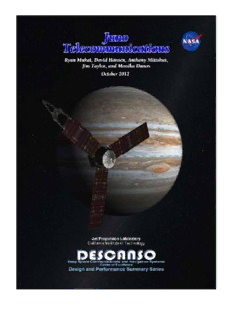
Article 16 Juno Telecommunications - DESCANSO - NASA PDF
Preview Article 16 Juno Telecommunications - DESCANSO - NASA
The cover The cover is an artist’s conception of Juno in orbit around Jupiter.1 The photovoltaic panels are extended and pointed within a few degrees of the Sun while the high-gain antenna is pointed at the Earth. 1 The picture is titled Juno Mission to Jupiter. See http://www.jpl.nasa.gov/spaceimages/details.php?id=PIA13087 for the cover art and an accompanying mission overview. DESCANSO Design and Performance Summary Series Article 16 Juno Telecommunications Ryan Mukai David Hansen Anthony Mittskus Jim Taylor Monika Danos Jet Propulsion Laboratory California Institute of Technology Pasadena, California National Aeronautics and Space Administration Jet Propulsion Laboratory California Institute of Technology Pasadena, California October 2012 This research was carried out at the Jet Propulsion Laboratory, California Institute of Technology, under a contract with the National Aeronautics and Space Administration. Reference herein to any specific commercial product, process, or service by trade name, trademark, manufacturer, or otherwise, does not constitute or imply endorsement by the United States Government or the Jet Propulsion Laboratory, California Institute of Technology. Copyright 2012 California Institute of Technology. Government sponsorship acknowledged. DESCANSO DESIGN AND PERFORMANCE SUMMARY SERIES Issued by the Deep Space Communications and Navigation Systems Center of Excellence Jet Propulsion Laboratory California Institute of Technology Joseph H. Yuen, Editor-in-Chief Published Articles in This Series Article 1—“Mars Global Surveyor Telecommunications” Jim Taylor, Kar-Ming Cheung, and Chao-Jen Wong Article 2—“Deep Space 1 Telecommunications” Jim Taylor, Michela Muñoz Fernández, Ana I. Bolea Alamañac, and Kar-Ming Cheung Article 3—“Cassini Orbiter/Huygens Probe Telecommunications” Jim Taylor, Laura Sakamoto, and Chao-Jen Wong Article 4—“Voyager Telecommunications” Roger Ludwig and Jim Taylor Article 5—“Galileo Telecommunications” Jim Taylor, Kar-Ming Cheung, and Dongae Seo Article 6—“Odyssey Telecommunications” Andre Makovsky, Andrea Barbieri, and Ramona Tung Article 7—“Deep Space 1 Navigation: Extended Missions” Brian Kennedy, Shyam Bhaskaran, J. Edmund Riedel, and Mike Wang Article 8—“Deep Space 1 Navigation: Primary Mission” Brian Kennedy, J. Edmund Riedel, Shyam Bhaskaran, Shailen Desai, Don Han, Tim McElrath, George Null, Mark Ryne, Steve Synnott, Mike Wang, and Robert Werner Article 9—“Deep Impact Flyby and Impactor Telecommunications” Jim Taylor and David Hansen Article 10—“Mars Exploration Rover Telecommunications” Jim Taylor, Andre Makovsky, Andrea Barbieri, Ramona Tung, Polly Estabrook, and A. Gail Thomas Article 11—“ Mars Exploration Rover Navigation” Louis A. D’Amario Article 12 —“Mars Reconnaissance Orbiter Telecommunications” Jim Taylor, Dennis K. Lee, and Shervin Shambayati v Article 13 —“Dawn Telecommunications” Jim Taylor Article 14 —“Mars Science Laboratory Telecommunications Systems Design” Andre Makovsky, Peter Ilott, and Jim Taylor Article 15 —“Phoenix Telecommunications” Jim Taylor , Stan Butman, Chad Edwards, Peter Ilott, Richard Kornfeld, Dennis Lee, Scott Shaffer, and Gina Signori Article 16 —“Juno Telecommunications” Ryan Mukai, David Hansen, Anthony Mittskus, Jim Taylor, and Monika Danos vi Foreword This Design and Performance Summary Series, issued by the Deep Space Communications and Navigation Systems Center of Excellence (DESCANSO), is a companion series to the DESCANSO Monograph Series. Authored by experienced scientists and engineers who participated in and contributed to deep-space missions, each article in this series summarizes the design and performance of major systems, such as communications and navigation, for each mission. In addition, the series illustrates the progression of system design from mission to mission. Lastly, the series collectively provides readers with a broad overview of the mission systems described. Joseph H. Yuen DESCANSO Leader vii Blank viii Preface Launched from Earth in 2011, the Juno spacecraft will arrive at Jupiter in 2016 to study the giant planet from an elliptical, polar orbit. Juno will repeatedly dive between the planet and its intense belts of charged particle radiation, coming only 5,000 kilometers (about 3,000 miles) from the cloud tops at closest approach. Juno’s primary goal is to improve our understanding of Jupiter’s formation and evolution. The spacecraft will spend a year investigating the planet's origins, interior structure, deep atmosphere and magnetosphere. Juno’s study of Jupiter will help us to understand the history of our own solar system and provide new insight into how planetary systems form and develop in our galaxy and beyond. This article is current as of September 14, 2012. As of that date, Juno had completed both parts of the Deep Space Maneuver. ix Blank x
Description: